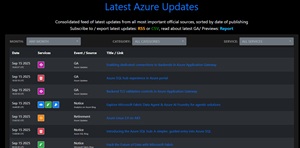News
Cloud AI Previews Offer a Glimpse of Future Enterprise Demands
Cloud providers are introducing preview features that show how enterprise expectations for AI services are evolving. Recent September 2025 documentation updates from Microsoft, Amazon Web Services (AWS) and Google emphasize security, operational control, and deployment flexibility for cloud-based AI platforms, aligning with enterprise demands as generative AI becomes part of production environments.
Microsoft Expands Azure AI With Security-Focused Previews
In its "What's New in Azure AI Services" page for September 2025, Azure listed several new preview features targeting enterprise use cases:
- Liveness detection with network isolation (preview): Adds the ability to restrict liveness detection operations within private networks, supporting regulated environments that require strict data boundaries.
- Improved document output quality: Incorporates confidence scoring, grounding, and in-context learning to enhance reliability of AI-generated document outputs.
- Voice-Live API language expansion (preview): Extends real-time voice interaction support to more languages, enabling broader deployment of voice-based AI assistants.
 [Click on image for larger view.] AI Featured in Latest Azure Updates (source: Microsoft).
[Click on image for larger view.] AI Featured in Latest Azure Updates (source: Microsoft).
Microsoft stated that these features are part of its ongoing effort to evolve Azure AI Services toward enterprise-grade trust and operational readiness. While the company did not provide specific release timelines, their appearance as preview features indicates they are expected to reach general availability after further testing and customer feedback cycles.
Reinforcement Fine-Tuning and GPT-OSS Deployment Paths
Also in September, Azure moved its Azure AI Foundry reinforcement fine-tuning (RFT) capability for the OpenAI o4-mini model to general availability. Azure documentation shows that RFT enables enterprises to customize base models on proprietary datasets, then deploy them through managed cloud endpoints with role-based access and network controls.
In addition, Azure published guidance for deploying GPT-OSS models as Azure Machine Learning online endpoints, giving enterprises a managed deployment path for open-weight models. This adds a new option alongside Azure's managed large language models, allowing organizations to combine open and closed models within the same cloud environment while applying consistent governance controls.
AWS Adds Knowledge Base Document Controls to Bedrock
Amazon Bedrock received a Sept. 3 update to its documentation describing a new capability to "view information about documents in your data source". The feature allows developers to inspect which documents are stored in Bedrock knowledge bases, including their ingestion status, sync timestamps, and metadata, using either the console or API.
AWS said this feature helps users verify document ingestion and synchronize knowledge bases with external content repositories. This aligns with enterprise requirements for transparency, auditability, and governance of the content used to power generative AI applications.
Context: Rising Demand for Secure AI Cloud Infrastructure
These feature rollouts come as demand for secure and scalable AI infrastructure continues to rise. A recent industry evaluation report published Sept. 8 highlighted that Microsoft Azure, AWS, and Google Cloud are leading the market by "AI-driven innovation, hybrid solutions, and global expansion," noting that AI workloads are driving major investments in cloud infrastructure and hybrid architectures.
The report stated that these vendors are accelerating their release cycles and expanding region coverage to support AI workloads at scale, particularly as enterprises shift from experimentation to production deployments.
Signals of What Enterprises Expect Next
Individually, these September updates are incremental. Taken together, they point to key enterprise expectations shaping how AI services are delivered through the cloud:
| Enterprise Priority |
Recent Cloud AI Features |
| Data Security & Isolation |
Azure's network-isolated liveness detection preview |
| Model Customization |
Azure AI Foundry's reinforcement fine-tuning GA |
| Operational Governance |
Bedrock's knowledge base document inspection feature |
| Real-Time Interaction |
Azure Voice-Live API language expansion |
These developments illustrate how recent AWS/Microsoft AI moves indicate enterprise adoption is pushing cloud AI platforms beyond model performance alone, toward surrounding infrastructure and operational capabilities. Security boundaries, governance controls, and flexible deployment models are becoming central requirements for AI in the cloud.
Google Cloud Focuses on Workflow and Evaluation Updates
While Microsoft Azure and AWS emphasized new preview features, Google Cloud made several quieter but notable changes in September 2025 that target developer workflows and model evaluation.
- On Sept. 10, Google added support for the Embeddings model in Batch API and enabled Batch API support through its OpenAI compatibility library, as noted in the Gemini API changelog. This helps enterprises process large document sets or prompts efficiently while easing interoperability with existing OpenAI-based pipelines.
- In its September release notes, Google added "summarization automatic evaluation" to its Agent Assist product, providing built-in metrics for Accuracy, Completeness, and Adherence. These metrics allow organizations to monitor the quality of model outputs directly within Google Cloud tooling.
- Google also updated its core Generative AI documentation on Sept. 4, reflecting ongoing maintenance of examples, code samples, and integration guidance for building generative AI systems on Google Cloud.
- Separately, Google published a migration guide for moving from the Vertex AI SDK to the newer Google Gen AI SDK, signaling that organizations using the older SDK will need to plan migration efforts to maintain support.
Enterprise Priorities Are Shaping Cloud AI Evolution
Taken together, the September 2025 updates from Azure, AWS, and Google show how enterprise needs are steering cloud AI development. Azure's focus on network isolation, model fine-tuning, and open-model deployment reflects rising demand for secure customization options. AWS's new knowledge base inspection controls address governance and auditability requirements. Google's additions around batch processing, SDK migration, and built-in evaluation metrics highlight an emphasis on operational efficiency and quality control. While each provider is taking a different approach, all are converging on the same goal: aligning cloud AI platforms more closely with the security, reliability, and oversight expectations of enterprise environments.
About the Author
David Ramel is an editor and writer at Converge 360.